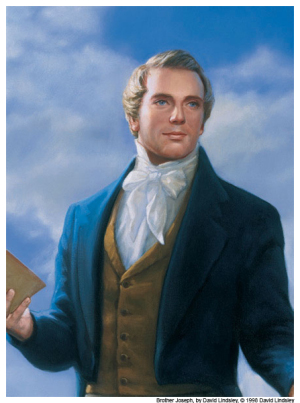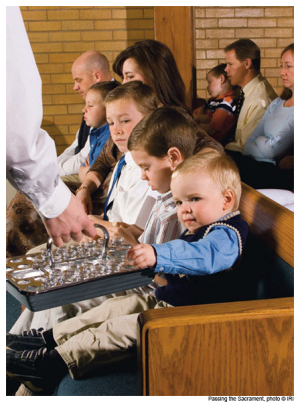Mormon Rites
A rite is a ceremony or ritual—usually associated with religious practice. Rites vary from religion to religion and church to church. Some religions are highly ritualistic with little worship that does not conform to the rigors of the ritual. Other religious practices are almost freestyle—worshippers are motivated by the spirit to participate as they see fit.
The Church of Jesus Christ of Latter-day Saints was organized in 1830 in New York State. This was a period of Christian revivalism in the northeastern United States, and most new converts to the Church were Protestants. Many had experienced spiritual manifestations to prepare them to receive the restored gospel of Christ. Mormonism, as it was later called, was not a Protestant church. Instead, it was the inspired restoration of Christ's ancient church along with the power and authority to act in God's name. Many new converts had grown disillusioned with their own churches and were looking for that one single, true church that manifested the power of God. Therefore, new members of the time were spiritually sensitive and were not necessarily looking for ritualistic worship.
Ritual, however, has qualities that are beneficial to the Lord to help the faithfulness of those who follow Him:
- Ritual provides an anchor for faith. It is constant and dependable and adds a secure and predictable aspect to worship.
- Certain parts of worship have been dictated by the Lord and need to be practiced exactly in order to guarantee the integrity of doctrine and behavior. Ordinances and covenants are examples.
- Rituals, because of their constancy over time, become traditions loaded with holding power for future generations. Often, tradition is stronger than belief.
- Rituals are symbolic. Symbolism helps to reinforce faith and understanding of doctrine.
- Some rituals also become milestones in the life or progess of members of a church. In Judaism, bar mitzvah is an example; in Catholicism, communion would be an example.
Joseph Smith received many instructions from the Lord while establishing the Church. As far as meetings were concerned, he received the following instruction from his translation of the Book of Mormon:
- And the church did meet together oft, to fast and to pray, and to speak one with another concerning the welfare of their souls. And they did meet together oft to partake of bread and wine, in remembrance of the Lord Jesus (Moroni 6:5, 6).
- And behold, ye shall meet together oft; and ye shall not forbid any man from coming unto you when ye shall meet together, but suffer them that they may come unto you and forbid them not (3 Nephi 18:22).
- And they did not walk any more after the performances and ordinances of the law of Moses; but they did walk after the commandments which they had received from their Lord and their God, continuing in fasting and prayer, and in meeting together oft both to pray and to hear the word of the Lord (4 Nephi 1:12).
In direct instruction from Christ, Joseph Smith received the following:
- The elders are to conduct the meetings as they are led by the Holy Ghost, according to the commandments and revelations of God. . . . And see that the church meet together often, and also see that all the members do their duty. . . . The several elders composing this church of Christ are to meet in conference once in three months, or from time to time as said conferences shall direct or appoint; And said conferences are to do whatever church business is necessary to be done at the time (Doctrine and Covenants 20:45, 55, 61).
From this basic instruction, we can gather that Latter-day Saint meetings are conducted according to revelation to general Church and local Church leadership. Sacrament meetings and ward, stake, and general conferences are organized according to patterns revealed to the prophet and are consistent church-wide. Content is mostly under the direction of local leadership, although classroom teaching manuals are the same church-wide. However, in sacrament meeting there is a ritual that is always the same throughout the Church. Sacrament prayers must be perfectly recited. (You can read them by clicking here.)
The sacrament consists of bread and water, which represent the body and blood of Christ, who suffered and died for our sins. When Latter-day Saints partake of the sacrament on Sundays, they are renewing the covenants they made at baptism—to take upon themselves the name of Christ and to always remember Him, that they then may have His Spirit to be with them.
Milestone Rituals of the Church of Jesus Christ
Blessing of Babies: The first milestone ritual in the Church of Jesus Christ is the blessing of babies. Giving a baby "a name and a blessing," is a rite that occurs whenever the parents feel the time is right during a baby's infancy. Most parents decide to do this when the baby is a few weeks old. This blessing is pronounced by a man who holds the Melchizedek priesthood, often the baby's father. Extended family gathers to witness the blessing, which may take place in a chapel during sacrament meeting (usually just prior to the normal pattern of the meeting) or in the home. If the blessing is held in a private home, the bishop of the family's ward attends. The event is recorded in the records of the Church, and the family receives a certificate.
Men who hold the Melchizedek Priesthood—close friends or family members of the parents—gather in a circle and hold the infant in their midst. The elder who gives the blessing invokes the name of Christ and the power of the priesthood. He then declares the name by which the baby will be known upon the earth and on the records of the Church. He then pronounces a blessing upon the child. The promises made in this blessing are received through revelation from God to the elder giving the blessing.
Baptism: Children are baptized by immersion at the age of eight, which Latter-day Saints call "the age of accountability." At this age, children are old enough to know right from wrong, and they are old enough to understand the process of repentance. A baptism can be performed by a "Priest," a holder of the highest station of the lower, or Aaronic priesthood. He performs the baptism "in the name of the Father, and the Son, and the Holy Ghost." Upon baptism, the child becomes a member of the Church. Of course, people older than eight can be baptized, and that is the case with adult or teenage converts. Latter-day Saints are only baptized once, unless a person is excommunicated from the Church and then repents. In that case, he is rebaptized into the Church.
Receiving the Holy Ghost: After baptism, a new member is qualified to receive the constant companionship of the Holy Ghost (as long as he or she remains worthy of this gift). The Holy Ghost is conferred by an elder (Melchizedek priesthood holder) by the laying on of hands. The elder lays his hands upon the head of the member and confers upon him or her the Holy Ghost. He can then pronounce a blessing by revelation.
Priesthood Ordinations: The first level of the Aaronic priesthood can be conferred upon boys the year of their twelfth birthday. Therefore, boys of that age begin to serve in "priesthood callings." It is akin to the Jewish tradition of bar mitzvah at the age of 13. If a young man progresses as an active Latter-day Saint, he will move on to higher priesthood ranks at age 14, 16, and 18.
The impression thus far is that the Church of Jesus Christ is not very ritualistic. This is true, until one takes a look at Latter-day Saint temple worship, which is all ritual. Temple ritual is highly symbolic and ancient or timeless in its feel. Temple rituals are always exactly the same—given by revelation to the prophets. They never vary unless the Lord requires it, and these adjustments are slight. The doctrine remains constant.
Temple Rites
Baptism for the Dead: The first temple ritual is baptism by immersion on behalf of the deceased. Since these ordinances are physical performances, those who have passed on, though they continue with personality and volition into the eternities, cannot perform these ordinances for themselves. So baptism is performed by proxy by a living person. The deceased can choose, then, whether to accept or reject the ordinance.
Conferring the Holy Ghost: After baptism, the Holy Ghost is conferred by the laying on of hands. An elder places his hands upon the head of the proxy to perform this ordinance. The person is requested to "receive the Holy Ghost."
Washing and Anointing: In preparation for the higher ordinances of the temple, each temple patron is symbolically washed and anointed once for himself/herself, and then after that for the deceased. A drop of oil or fingertip dipped in water provides the symbolism for the ancient rites of washing and anointing. Ordinance prayers are recited from memory by temple workers, and must always be exact.
The Temple Endowment: The temple endowment endows the temple patron with power from on high. The endowment ceremony presents the Plan of Salvation, beginning with the creation and progressing toward eternal life. Covenants are made with the Lord during the endowment. These covenants are promises to live a righteous life, and to keep oneself pure and undefiled by the world. At the end of the endowment ceremony, patrons (dressed in white) proceed from the endowment room to the "celestial room," which is decorated to represent the heavenly realm. There the patron can sit and meditate or pray. The covenants of the endowment must be recited exactly.
Sealings: In the temple, the worthy Church member can be sealed to parents or to his or her spouse for all eternity. Temple sealing to one's spouse is eternal marriage. Marriage, of course, is a milestone ritual, and the qualifications are strict. To be considered temple worthy, participants must keep the Word of Wisdom (health laws), pay a full 10 percent tithe to the Church, and live a dedicated Christian life.
Last Rites
Dressing and preparing the dead for burial is another church rite. When a person dies, if he or she was an endowed member of the Church, he or she is dressed in his or her temple clothes for burial. In some areas of the world, cultural traditions or burial practices make it difficult to dress the deceased in temple clothes, so clothing may be folded and placed next to the body in the casket.
After the funeral, the grave is dedicated by a Melchizedek priesthood holder. This is the final milestone rite of the Church of Jesus Christ.

